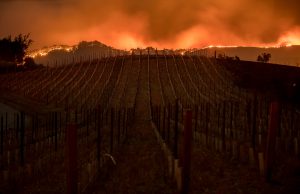Have you ever tried freezing grapes to enjoy as a refreshing snack on a hot day? Someone had the brilliant idea to use frozen grapes to make wine and the end result is ice wine, a truly unparalleled wine experience!
Many people think of frolicking through the vineyards, touring the wineries on warm spring and summer days or even in the coolness of fall. But one of the best ways is to set your sites along the Niagara Escarpment and Lake Ontario where you’ll find this sweet dessert wine.
The sugars that are naturally present in the grapes don’t freeze so it creates a stunningly sweet and highly acidic drinking experience. It’s a labor of love to craft such wines, one that yields small amounts due to the difficulty in production. On the surface, you might think ice wine is just a fancy dessert wine, but because of this production, it is much more expensive and comes in smaller bottles.
It all started in this region in 1984 at the Inniskillin winery where Karl Kaiser of Austria crafted the first ice wines in Canada. Inspired by Walter Hainle who created ice wine in 1972 in the Okanagan Valley, the ice wines were intensely difficult to produce. Others that would follow suit would learn immense disappointment from hungry birds devouring their crops. It was Kaiser though that found success in 1984 for using nets to protect the vines and hence, earning the distinction of being the first to create ice wine for Inniskillin.
From there, Canadian ice wine became very popular, particularly in 1991 as the 1989 Inniskillin Vidal ice wine took home the Grand Prix d’Honneur at the Vinexpo. Soon, Canada would become the largest producer for ice wine anywhere in the world. One of the greatest reasons is that ice wine, despite having a high sugar content, isn’t as cloyingly sweet as other dessert wines. It has a refreshing quality due to the high acidity.
It does have an alcohol content that is slightly lower than regular wines. In Canada though, it has an alcohol content between 8% and 13% It has a very intense amber color that evokes a tropical feel. Serving it chilled before a meal or enjoying it afterwards is an ideal choice. Furthermore since its early years when the Hybrid Vidal was the most commonly used grape, today most quality ice wines are done from Vitis vinifera grapes including some great examples from red grapes.
Ice wine from Niagara-on-the-Lake is ideal with rich foods. Serving it with a bold cheese plate that has blue cheese is a luscious pairing. Pâté makes for another sophisticated match. You should notice flavors of baked sweet fruits like pear and apricots with a mineral flourish.
While ice wine seems to be heavily adored by those who get to taste it, the Japanese are particularly enamored with it. In Japanese culture, the gift-giving aspect is a seasonal thing, not to mention the tourism to this area which has created an impressive segment of the market for ice wine.








4 thoughts on “The Big Chill: Why Niagara-on-the-Lake Ice Wine Creates Your Perfect Winter Wonderland”
Fantastic site. A lot of useful information here. I’m sending it to
some buddies ans additionally sharing in delicious.
And naturally, thank you for your effort!
What’s Happening i am new to this, I stumbled upon this I have
discovered It positively helpful and it has aided me out loads.
I am hoping to contribute & aid other users
like its helped me. Good job.
This website was… how do I say it? Relevant!!
Finally I’ve found something that helped me. Many thanks!
tireslist.com
When someone writes an piece of writing he/she retains the plan of a user in his/her brain that how a
user can understand it. Thus that’s why this article is amazing.
Thanks!